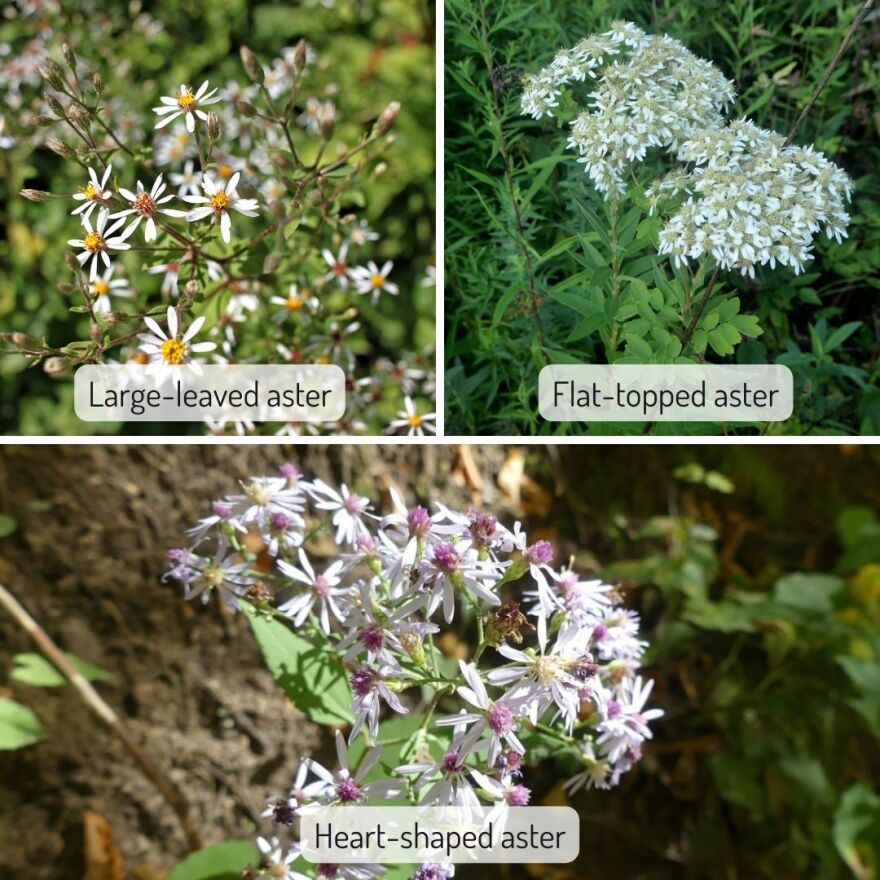Welcome back to another week of John's phenology report! He begins with the late summer flowers, which have just started to bloom. It's the time of year when goldenrods and asters are beginning to show their colors, with three asters flowering, two goldenrods flowering, and one goldenrod at the cusp of flowering. The first aster John notes is the large-leaved aster, a purplish/bluish flower with a yellow center, with distinctive gaps in the petals or "rays." John says, "If you're looking at an aster and it looks as though some mischievous little child has come along and pulled a few of the rays out here and there, that is probably a large-leaved aster." If you want further confirmation, look for large leaves lower on the stem, culminating in gigantic leaves (as big as your hand or bigger) at the base of the stem. This is how the large-leaved aster got its name! The second aster flowering at the moment, the flat-topped aster, which usually blooms around the end of July, bloomed on August 1st. This plant has white flowers with a complete set of rays. These flowers are set in clusters of 7-10 inches across. Within each cluster, all the flowers are positioned at the same height, giving the name "flat-top aster." The third aster blooming right now is the Northern heart-leafed aster, which has a blue flower with a yellowish-orange center. The flower has a complete set of rays, unlike the large-leafed aster (which is also bluish). As you look down the plant's stem, the leaves don't get larger, but they get more heart-shaped and have a reddish stem.
John's also observed two goldenrods blooming right now. The flat-topped goldenrod (also known as the grass-leaved goldenrod) has extremely narrow leaves with yellow flowers. The flowers form a flat top (though the disc is smaller than the flat-topped aster's). The leaves are about 1/4 inch long and 2.5-3 inches long, so they are remarkably long and narrow. Another goldenrod that bloomed this week is the Canada golden rod, which is very tall with a more typical plume of flowers at the top. The leaves of this goldenrod are 3-4 inches long and toothed, with the teeth growing more prominent on the outer end of the leaf. The Canada goldenrod is just beginning to bloom this week! The goldenrod in full bloom right now is the early goldenrod, which we discussed last week. John's gray goldenrods are turning yellow, but the buds aren't open yet. They'll open very soon. The flowerhead of the grey goldenrod is roughly the thickness of your thumb but much longer: up to 5-6 inches long with a slight bend. The flowerheads form a long tubular structure at the top of the gray goldenrod.

John has noticed other flowers beginning to bloom this week. One such was the Joe Pye-weed, which flowered later than usual; it usually blooms around July 21st but flowered on July 28th or 29th this year. John also saw horseweed beginning to bloom. Horseweed is a 3-4 foot tall plant with many tiny white flowers in a column. The flowers are not tightly packed together and appear as little white dots all over the top of the plant. In addition, boneset, jewelweed, hedge bindweed, sawtooth sunflower, meadowsweet, creeping bellflower, and blackeyed Susans are all abundant right now!
One flower nearing the end of its blooming period is the smooth vetch. This plant has purple, pea-like flowers clustered in groups of eight or ten. If you're curious, you can look closer to the areas where branches break off from the stem: these areas have stipules, which are leaflike structures with three sharp points on the lower half and a sharp point in front. They are quite interesting to observe if you have the chance to view one up close!
You can find many fruits right now, including blueberries and raspberries. John found that the raspberries are so ripe that "yesterday, while I was walking along, I was downwind of a patch of raspberries I could smell them: they were that ripe." Juneberries are also plentiful, so get out and find a few!
Among the non-edible fruits are:
- Chokecherries, which are taking a blush but not yet ripe
- Nannyberries, which are still green
- Black chokeberries, which are beginning to show some color
- Baneberries, which have bright red berries found at the top of the plant
- Bluebead lily, which has blue berries about 1/4th of an inch in diameter.
- Mountain ash, whose berries are starting to turn orange.
John posted a picture of the debris deposited by chipmunks eating hazelnuts on the Season Watch Facebook page. They're hungry critters, so you'll have to move quickly if you want to beat them to the hazelnuts! John suspects that they'll be gone by the end of the week: bears, deer, woodchucks, chipmunks, and squirrels are all after the harvest as well. The earliest date John has ever observed ripe hazelnuts was July 21st, 2012. The latest record was on August 21st, 2008, and on the same date in 2013. Since the eighties, the trend has been that hazelnuts are ripening later in the season. This year, however, they ripened in the middle to the early side of the range found in John's phenology records.

John concludes with a note on crows! He saw a flock (or murder) of crows in a hayfield this week comprised of about a dozen individuals. By the end of the month, the flocks will consist of a hundred or more individuals eating grasshoppers or whatever else they can find.
See something noteworthy? We would love to hear from you! Get in touch with me (smitchell@kaxe.org) or John (jlatimer@kaxe.org), or text 'phenology' to 218-326-1234.
For more phenology content, subscribe to our Season Watch newsletter!






